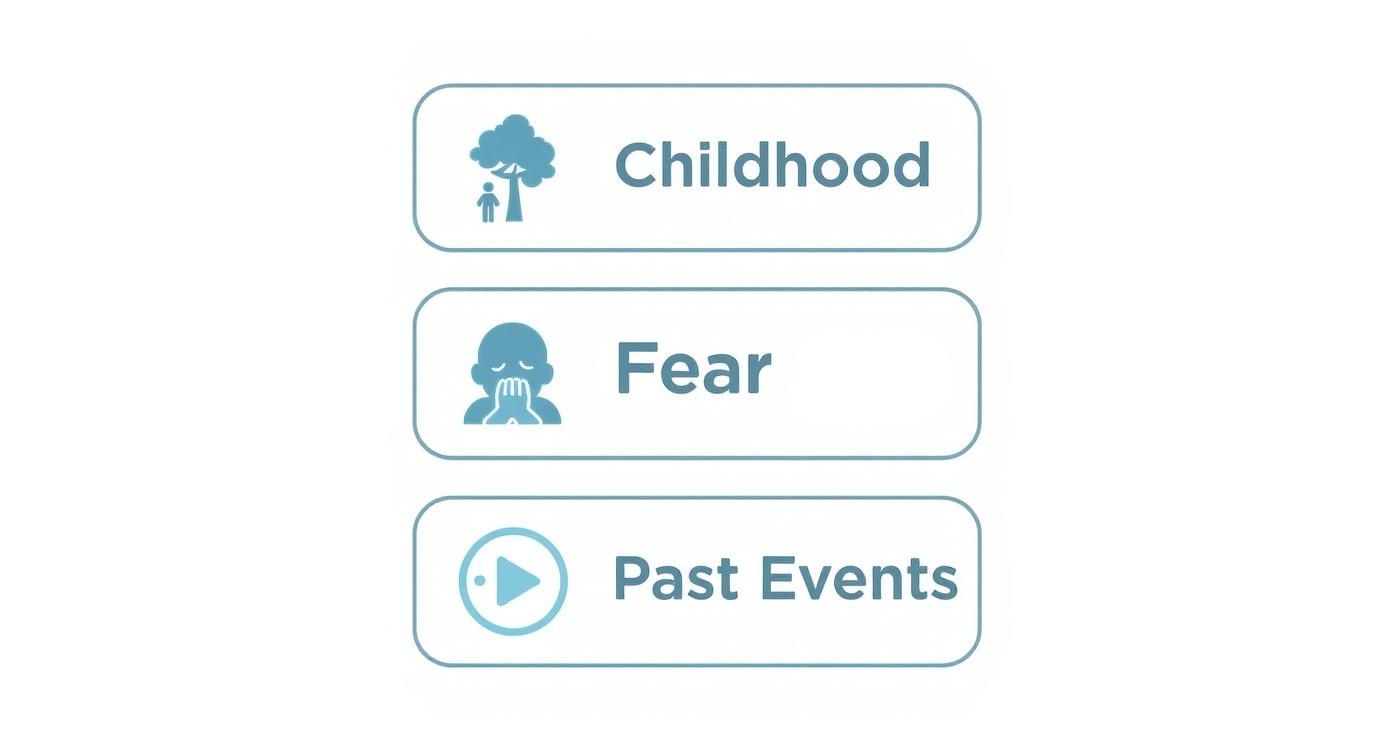How Can I Stand Up for Myself A Practical Guide
- Kizito WIX partner
- 12 minutes ago
- 13 min read
By Therapy-with-Ben
If you're wondering, "how can I stand up for myself?", a good place to start is simply understanding that your needs are completely valid, and you have every right to express them. This isn't about becoming confrontational. It’s about learning to communicate your feelings and boundaries with respect.
The whole process begins when we stop seeing this as some kind of personal failing and start treating it as a practical skill we can build over time.
Why It Feels So Hard to Speak Up
Ever felt completely frozen at the exact moment you needed to say something important? You are far from alone. The question of how to stand up for yourself often comes with a real knot in your stomach because the reasons we stay quiet are usually deeply ingrained. It's rarely a simple case of being shy; it's often about learned behaviours and powerful emotional responses that scream at us to just keep the peace.
These patterns frequently trace back to our childhoods, where we might have learned that being agreeable was a much safer bet than voicing a different opinion. Or perhaps past experiences, where speaking up led to some kind of negative fallout, have taught us to retreat. This creates a difficult cycle where the fear of potential conflict completely outweighs the need to express what's true for us.
When you're up against that powerful internal resistance, learning some healthy coping mechanisms for stress can make a world of difference.
The Roots of Our Reluctance
The first step to breaking this cycle is to normalise these feelings. Your hesitation isn't some character flaw; it's a protective mechanism that, at some point, probably served a real purpose.
Here's the good news: assertiveness is not a fixed personality trait. Think of it like learning a new language – it's a skill that can be developed with a bit of practice and patience. Recognising the deep-seated reasons for your silence is a huge first step.
The infographic below neatly summarises three common roots of this struggle: childhood conditioning, a deep fear of conflict, and the lasting impact of negative past experiences.

As you can see, our reluctance to speak up is often a complex mix of past and present influences. These factors can feel especially challenging in professional settings. In the UK, for instance, a toxic workplace can be a significant barrier. Research shows that nearly one in four workers has experienced bullying, often from managers. This kind of power dynamic naturally reinforces silence, making it vital to create work cultures where people feel safe enough to speak.
To help distinguish between the different ways we might respond in these situations, it's useful to look at the core differences between passive, assertive, and aggressive communication.
Passive vs Assertive vs Aggressive Responses
Communication Style | Core Belief | Verbal Cues | Impact on Self |
|---|---|---|---|
Passive | "Your needs matter more than mine." | "It doesn't matter," "I'm sorry," Apologetic tone | Resentment, low self-esteem, unmet needs |
Assertive | "My needs and your needs both matter." | "I feel...", "I need...", "Let's find a solution." | Confidence, self-respect, needs are met |
Aggressive | "My needs matter more than yours." | "You always...", "You're wrong," Blaming, loud tone | Damaged relationships, guilt, isolation |
This table is a quick guide to help you identify your own patterns and those of others. The goal is to move towards that assertive middle ground, where respect flows both ways.
The goal isn't to become fearless overnight. It's about learning to act despite the fear, understanding that your voice has value and deserves to be heard.
By exploring these underlying causes, you can begin to gently untangle the knots of self-doubt and fear. This self-awareness is the foundation upon which all other assertive communication skills are built, transforming what feels like an insurmountable obstacle into a manageable journey of personal growth.
Building Your Foundation of Self-Worth

Before you can really stand up for yourself, you have to believe you have the right to. This isn't about becoming arrogant or demanding; it's about fostering a quiet, steady sense of self-worth that acts as an anchor in those tricky conversations. The whole practice of advocating for your needs starts with the deep-down conviction that your needs are valid in the first place.
This internal work is the essential groundwork. Without it, all the assertive phrases and clever techniques in the world will feel hollow and fake. They'll fall flat the moment you're under pressure.
So, let's move from theory into practice. One of the most powerful tools I use with my clients is what I call the ‘Personal Bill of Rights’ exercise. It’s a straightforward way to make your rights tangible and codify what you are entitled to in any relationship, whether that’s at home or at work.
Define Your Personal Bill of Rights
Creating this list helps you build a conscious awareness of your own value. Think of it as a constant reminder that your rights don’t just vanish because someone else disagrees or pushes back. It is a declaration of self-respect.
Grab a blank page and start thinking about the fundamental rights you believe every person—including you—deserves. If you’re stuck, here are a few ideas to get the ball rolling:
You have the right to say "no" without feeling guilty.
You have the right to be treated with respect.
You have the right to change your mind.
You have the right to make mistakes and not be perfect.
You have the right to express your thoughts and feelings, even if they’re different from others'.
This is just a starting point, not an exhaustive list. Make it your own. Tailor it to your life and the specific situations where you find it hardest to speak up. Reading this list regularly really helps to solidify these beliefs until they become second nature.
Acknowledging your rights on paper makes it harder to ignore them in real life. It transforms an abstract feeling of being wronged into a concrete violation of a right you have already claimed for yourself.
This process is a core part of improving your overall wellbeing. For more on this, our collection of articles on mental health offers some great perspectives and strategies.
Challenge Your Inner Critic
We all have that persistent, negative inner voice. It's the one that undermines our self-worth, whispering that we’re being "difficult" or "selfish" just for having needs. To advocate for yourself effectively, you have to learn to challenge this internal narrative. Journaling is a fantastic way to start.
Try these prompts to begin untangling that negative self-talk:
When I think about speaking up, what’s the worst-case scenario my mind jumps to? Is this fear based on actual evidence, or is it just a feeling?
Write about a recent time you didn't stand up for yourself. What was your inner critic saying to you in that moment?
What’s one small, low-stakes situation this week where I can practise honouring one of my Personal Rights?
By consistently defining your rights and challenging the voice that tells you they don't matter, you build a resilient foundation of self-worth. This is the bedrock upon which all true assertiveness is built.
Learning the Language of Assertiveness
Knowing you have the right to speak up is one thing, but how you actually do it is a whole other skill. This is where we get into the nuts and bolts of communicating with clarity and confidence. Think of it like learning a new language – you need the right words and techniques to get your point across effectively, without causing unnecessary conflict.
Forget vague advice. Real assertiveness isn't about being aggressive or blaming others. It’s a fine art, a balance between expressing your own needs and respecting the other person. The aim is to be understood, not to win an argument.
And one of the most powerful tools in this new language? The simple 'I' statement.
Mastering 'I' Statements
'I' statements are all about owning your feelings and needs without pointing the finger. They shift the conversation away from accusatory 'you' statements ("You did this wrong") to focus on how someone's actions have impacted you. This small change can work wonders in lowering the other person's defences, paving the way for a real conversation.
Look at the difference:
Instead of: "You always exclude me from decisions."
Try: "I feel overlooked when decisions are made without my input."
The first one sounds like an attack, doesn't it? It's almost guaranteed to make someone defensive. The second, however, is simply an honest expression of your own experience. It’s hard to argue with. It invites a bit of empathy rather than kicking off a fight.
Using 'I' statements isn't about watering down your message; it’s about making it crystal clear. You're stating your reality without making assumptions about their motives.
This is especially important in tricky situations, like at work. Self-advocacy can feel incredibly risky, particularly when you consider issues like workplace discrimination here in the UK. A recent survey found that a staggering 45% of UK adults have faced some form of discrimination at work. In that kind of environment, being able to state your case calmly and clearly is essential for getting the support you need. You can read the full workplace discrimination research from Ciphr for a deeper dive into the findings.
Staying Firm with the Broken Record Technique
Sometimes, being clear just isn’t enough. You might find yourself dealing with someone who keeps pushing back or just isn't getting your 'no'. For moments like these, the 'Broken Record Technique' is your friend. It’s pretty simple: you just calmly repeat your main point, using similar words, without getting dragged into endless arguments or justifications.
Picture a colleague piling extra work on you:
You: "I understand the project is important, but I don't have the capacity to take that on right now."
Them: "But it'll only take an hour. We really need your help."
You (Broken Record): "I appreciate that, but as I said, I don't have the capacity right now."
You don’t have to invent new excuses. Your original reason is perfectly valid. The real power here is in the calm, persistent repetition. If you're looking for more tools like this, you might find something useful in our collection of free mental health resources.
The Power of Non-Verbal Communication
Finally, don't forget that your words are only half the story. Your body language – your posture, how you hold eye contact, your tone of voice – says just as much, if not more.
Posture: Sit or stand tall, with your shoulders back and relaxed. It sends a message of confidence before you’ve even opened your mouth.
Eye Contact: Keep your eye contact steady and natural. It shows you're present and that you mean what you say.
Tone of Voice: Aim for a calm, firm, and even tone. Try not to mumble or let frustration creep in and raise your voice.
When your body language is in sync with your words, your message lands with so much more weight. It tells the other person – and just as importantly, it tells yourself – that you are serious and self-assured.
How to Set and Defend Your Boundaries

When people ask, "how can I stand up for myself?", the conversation nearly always comes back to boundaries. Think of them as the most powerful, practical way you can show yourself some respect. They're the invisible lines we draw that quietly tell others how we expect to be treated.
This isn't about building massive walls to keep everyone out. It’s more like installing a gate—you get to decide what and who you let into your life. The goal is to protect your most precious resources: your time, your energy, and your emotional wellbeing.
I get it, the biggest hurdle is often the fear of upsetting people. We’re wired to worry that saying "no" makes us seem selfish or unkind. But there’s a massive difference between being a good person and being a doormat. Real kindness has to include being kind to yourself first.
Identifying Your Personal Limits
Before you can tell anyone where your line is, you have to know where to draw it. This takes a bit of honest self-reflection. A good place to start is to simply notice when you feel resentful, stressed out, or completely drained after an interaction. Those feelings are massive signposts, pointing directly to a boundary that’s been crossed.
Think about these key areas of your life:
Your Time: Are you the person who says "yes" to everything, leaving no time for what actually matters to you? A boundary here could be something as simple as not checking work emails after 6 pm.
Your Energy: Do certain people or conversations just leave you feeling exhausted? That’s a sign. Your boundary might be to limit the time you spend with that person.
Your Emotions: Are you the go-to person for everyone else's emotional drama or intrusive questions? A healthy boundary might be saying, "I'm not comfortable talking about that."
Just pick one area where you feel your limits are constantly being pushed. That’s the perfect place to start practising.
Setting a boundary isn't a confrontation; it's a clarification. You are simply teaching someone how to treat you by showing them what is and isn't acceptable. This act of self-advocacy is vital for your mental health.
Scripts for Clear and Kind Communication
Once you’ve identified a boundary, the next bit is communicating it. The trick is to be clear, calm, and firm, but not aggressive. You also don't need to give a long-winded explanation or justification.
Here are a few practical scripts you can make your own:
For protecting your work-life balance: "Thanks for thinking of me for this. Unfortunately, I don't have the capacity to take on anything new right now."
For dealing with intrusive questions: "I appreciate your curiosity, but I'd rather keep my personal life private."
For handling any pushback: "I understand this might be disappointing for you, but my decision is firm."
You'll notice none of these phrases start with "I'm sorry, but...". Dropping the apology immediately adds strength to what you're saying. You have a right to your limits, and you never need to apologise for having them.
When someone pushes back or tries the old guilt-trip, it’s so tempting to cave. This is where you have to hold firm. You can calmly repeat your boundary, almost like a broken record. Their reaction is their responsibility to manage; your boundary is yours to hold. Each time you do it, you reinforce your own self-worth and teach others to respect your limits.
Navigating High-Stakes Conversations

It’s one thing to stand up for yourself in a low-stakes moment, but quite another when emotions are running high or you’re dealing with a power imbalance. This is where self-advocacy can feel most daunting—think of addressing unfair treatment from a manager or confronting a partner about hurtful behaviour.
The key is to shift your mindset away from confrontation and towards resolution. This isn't about a dramatic showdown; it's about calm, prepared persistence. I find the most productive conversations happen when you’ve done the groundwork beforehand, helping you stay centred even when things get difficult.
Feeling a knot of anxiety tighten in your stomach before these conversations is completely normal. If you find this stress particularly challenging to manage, exploring specific strategies through anxiety counselling in Cheltenham can provide tailored support to build your confidence.
Prepare Your Strategy Before You Speak
Walking into a tough conversation without a clear plan is like setting sail without a rudder. Your emotions can easily take over and steer the discussion completely off course. Good preparation is your anchor, keeping you focused on what truly matters.
Start by clarifying your one key objective. What is the single most important outcome you want? Is it an apology? A change in behaviour? Or simply to feel heard? Trying to tackle too many issues at once just dilutes your message and makes it harder for the other person to take on board.
Next, try to anticipate the other person's potential reactions. How might they respond? Thinking through the possibilities—defensiveness, anger, dismissal—allows you to prepare calm responses in advance so you’re not caught off guard.
Grounding Techniques to Stay Calm Under Pressure
When your heart starts racing and your palms get sweaty, your body is kicking into fight-or-flight mode. It's almost impossible to think clearly in this state. This is where grounding techniques become so valuable.
Before the conversation, try a simple breathing exercise:
Inhale slowly through your nose for a count of four.
Hold your breath for a count of four.
Exhale slowly through your mouth for a count of six.
Repeat this a few times until you feel your heart rate slow down.
During the chat, if you feel yourself becoming overwhelmed, subtly press your feet firmly into the floor. Feel the solid ground beneath you. This simple physical act can pull your focus back to the present moment and away from that rising panic.
Your goal is to de-escalate, not dominate. By staying calm and focused on your objective, you create an environment where the other person is more likely to listen, paving the way for a genuine resolution.
This preparation is especially crucial in professional settings. In the UK, workplace bullying affects over 9 million workers and is estimated to cost businesses £18 billion a year. These numbers show just how vital it is for individuals to feel equipped to address unfair treatment.
For specific strategies on navigating these discussions at work, you might find this guide helpful: How to Have Tough Conversations.
Your Questions on Assertiveness Answered
Stepping into this new way of being and learning to stand up for yourself will naturally kick up some anxieties and "what if" scenarios. I see this all the time, and it's completely normal. So, let's tackle some of the most common fears I hear from clients, with some practical thoughts to help you navigate these moments.
What if the Person Gets Angry When I Stand Up for Myself?
This is probably the biggest and most valid fear of them all. When this happens, the real challenge is to stay calm and focus on your message, not on their reaction. You're in control of what you say and do, but you can't control how they feel.
You could try saying something like, "I can see this is difficult to hear, but this is important to me." If you feel their anger is escalating, your safety is the absolute priority. It is always okay to end the conversation. A simple, "I don't think we can resolve this right now," followed by physically walking away is a perfectly acceptable response. You can always come back to it later, perhaps with a mediator if it's a situation at work.
How Do I Stop Feeling So Guilty Afterwards?
Ah, guilt. It's a powerful emotion, isn't it? It often comes from a deeply ingrained belief that putting your own needs on the table is selfish. The key is to start reframing that thought: setting a boundary is an act of self-respect, not selfishness. It's actually fundamental to building healthy, balanced relationships.
Remind yourself that you are not responsible for managing other people's emotional responses to your boundaries. Your only responsibility is to communicate your needs kindly and clearly.
To help push back against the guilt, go back and look at your 'Personal Bill of Rights' that we talked about earlier. It's a great way to reinforce the idea that your needs are valid. I also suggest starting small. Try asserting yourself in low-stakes situations first. When you see that the world doesn't fall apart and you experience the positive results, those feelings of guilt will naturally start to fade.
Is There a Difference Between Being Assertive and Being Rude?
Yes, absolutely – and getting this distinction right is vital. Assertiveness is about respecting yourself *and* the other person. It’s about stating your needs clearly and honestly, while still acknowledging their right to their own thoughts and feelings. The goal is to find a middle ground, a 'win-win' where everyone feels heard.
Rudeness, or aggression, is totally different. It steamrolls the other person's rights and feelings. It's all about dominating, controlling, or blaming, which is a classic 'win-lose' approach. You'll notice that assertive communication often uses "I feel..." statements, whereas aggression tends to rely on blaming "You always..." language.
Finding your feet with this is a journey of practice and self-discovery. If you feel you could do with some personalised support in building your confidence and learning how to stand up for yourself, Therapy with Ben offers a compassionate and supportive space to explore these skills. You can find out more about how counselling can help by visiting https://www.therapy-with-ben.co.uk.

.jpg)



Comments